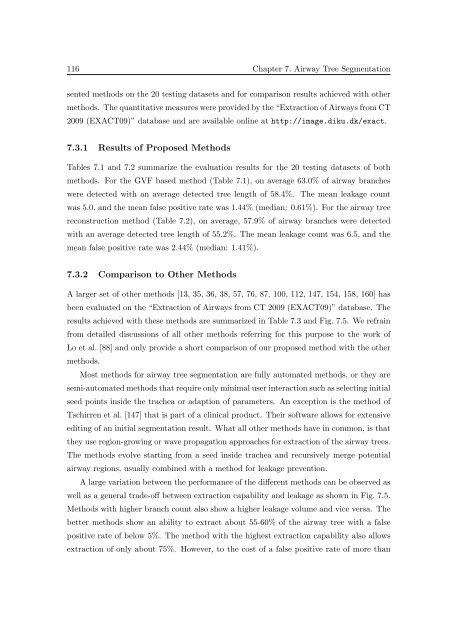Segmentation of 3D Tubular Tree Structures in Medical Images ...
Segmentation of 3D Tubular Tree Structures in Medical Images ...
Segmentation of 3D Tubular Tree Structures in Medical Images ...
Create successful ePaper yourself
Turn your PDF publications into a flip-book with our unique Google optimized e-Paper software.
116 Chapter 7. Airway <strong>Tree</strong> <strong>Segmentation</strong><br />
sented methods on the 20 test<strong>in</strong>g datasets and for comparison results achieved with other<br />
methods. The quantitative measures were provided by the “Extraction <strong>of</strong> Airways from CT<br />
2009 (EXACT09)” database and are available onl<strong>in</strong>e at http://image.diku.dk/exact.<br />
7.3.1 Results <strong>of</strong> Proposed Methods<br />
Tables 7.1 and 7.2 summarize the evaluation results for the 20 test<strong>in</strong>g datasets <strong>of</strong> both<br />
methods. For the GVF based method (Table 7.1), on average 63.0% <strong>of</strong> airway branches<br />
were detected with an average detected tree length <strong>of</strong> 58.4%. The mean leakage count<br />
was 5.0, and the mean false positive rate was 1.44% (median: 0.61%). For the airway tree<br />
reconstruction method (Table 7.2), on average, 57.9% <strong>of</strong> airway branches were detected<br />
with an average detected tree length <strong>of</strong> 55.2%. The mean leakage count was 6.5, and the<br />
mean false positive rate was 2.44% (median: 1.41%).<br />
7.3.2 Comparison to Other Methods<br />
A larger set <strong>of</strong> other methods [13, 35, 36, 38, 57, 76, 87, 100, 112, 147, 154, 158, 160] has<br />
been evaluated on the “Extraction <strong>of</strong> Airways from CT 2009 (EXACT09)” database. The<br />
results achieved with these methods are summarized <strong>in</strong> Table 7.3 and Fig. 7.5. We refra<strong>in</strong><br />
from detailed discussions <strong>of</strong> all other methods referr<strong>in</strong>g for this purpose to the work <strong>of</strong><br />
Lo et al. [88] and only provide a short comparison <strong>of</strong> our proposed method with the other<br />
methods.<br />
Most methods for airway tree segmentation are fully automated methods, or they are<br />
semi-automated methods that require only m<strong>in</strong>imal user <strong>in</strong>teraction such as select<strong>in</strong>g <strong>in</strong>itial<br />
seed po<strong>in</strong>ts <strong>in</strong>side the trachea or adaption <strong>of</strong> parameters. An exception is the method <strong>of</strong><br />
Tschirren et al. [147] that is part <strong>of</strong> a cl<strong>in</strong>ical product. Their s<strong>of</strong>tware allows for extensive<br />
edit<strong>in</strong>g <strong>of</strong> an <strong>in</strong>itial segmentation result. What all other methods have <strong>in</strong> common, is that<br />
they use region-grow<strong>in</strong>g or wave propagation approaches for extraction <strong>of</strong> the airway trees.<br />
The methods evolve start<strong>in</strong>g from a seed <strong>in</strong>side trachea and recursively merge potential<br />
airway regions, usually comb<strong>in</strong>ed with a method for leakage prevention.<br />
A large variation between the performance <strong>of</strong> the different methods can be observed as<br />
well as a general trade-<strong>of</strong>f between extraction capability and leakage as shown <strong>in</strong> Fig. 7.5.<br />
Methods with higher branch count also show a higher leakage volume and vice versa. The<br />
better methods show an ability to extract about 55-60% <strong>of</strong> the airway tree with a false<br />
positive rate <strong>of</strong> below 5%. The method with the highest extraction capability also allows<br />
extraction <strong>of</strong> only about 75%. However, to the cost <strong>of</strong> a false positive rate <strong>of</strong> more than















